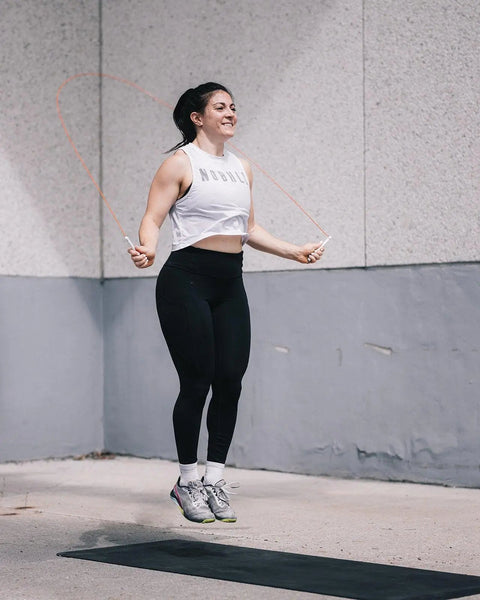The Right Way to Jump Rope to Prevent Injury
Sep 14, 2022Jordan Lindstrom

Jumping Rope has fast become a hit in our generation. Boxers were among the first to discover the amazing cardiovascular and core strength benefits of skipping rope. More recently, jump rope has seen an explosion of popularity because of the growth of CrossFit.
Crossfit includes double under jumping (1 jump, 2 spins of the rope) as an event in their competitions. However, many people with knee problems and back conditions shy away from this type of workout. This is for good reason. Jumping up and down on two feet hundreds and thousands of times in a row is tough on joints, and soft tissues. The force on the knee and back joints can be stressed at unhealthy levels.
We have had many people ask us about using jump rope as part of a future or ongoing personal exercise program. We cannot encourage people enough to jump rope. But, do it the right way!
I like to encourage people to incorporate jumping rope as a part of their overall fitness program. There are so many benefits to this unique skill and exercise. I mentioned “skill” because it is a learned activity that not everybody can do right away like they can running.
There is a learning curve that has to take place before you can get the full benefits of this workout. Some people pick it up faster than others. However, it is not so difficult that all people can't learn. Start slow and practice jumping rope a little bit every workout. Don’t be discouraged if you are not jumping like a pro right away. Be patient with yourself. I guarantee success for all who jump rope, (even just a minute or two) every workout. I suggest making jump rope just a small part of your workout, not the whole thing. This plyometric workout will pay huge dividends in strength, stamina and overall health.
If you need some help getting started, here is an article on learning to jump rope.
There are many ways to jump rope, but there is a “Right Way” to jump. Jumping on two feet is the proper technique to learn how to jump rope. However, when your skill level gets to a point where you can do 50 jumps in a row without a miss, then you should ramp up your skill level to the Jog Step skill (alternating feet).
There are a couple of reasons you need to quickly move on to the Jog Step. The first and most important reason is the vertical force that it is put on your joints. Jumping on two feet is really a hopping motion. Humans were designed to do many motions continuously, but hopping is not one of them. Speaking from experience, the motion of jumping on two feet over and over for 5-10 minutes at a time was hard on my legs and back joints. Not to mention a very monotonous movement.
However, when I began to jump rope with a jogging motion, (alternating feet every turn of the rope) it made jumping rope a more natural motion. Humans are designed to move predominately through walking. This is a motion that shifts weight back and forth from one leg to the other just like the Jogging Step does.
That is why boxers have turned to using the “Boxers Shuffle” when jumping rope. The Boxers Shuffle is shifting weight to one foot, back to two feet and then back to the other foot. Even though all of the weight is landing on one foot, there is very low impact on the body since the jump only needs to be 1-2 inches off the ground.
I also recommend using a jump rope mat to reduce impact on your knees and back when jumping.
Make jumping rope a part of your exercise regiment. It spices up the routine and has wondrous benefits that people have been leveraging to build impressive cardio fitness for a long, long time. But, after you learn the basic 2 foot jump, move to the Jog Step or Boxer’s Shuffle to get the full benefit and joy of jumping rope.
We're all about equipping and encouraging people to take on big challenges, because we know the process of doing hard things helps us grow in character and capacity.
Frequently bought together
You may also like
0 Comments
There are no comments for this article. Be the first one to leave a message!